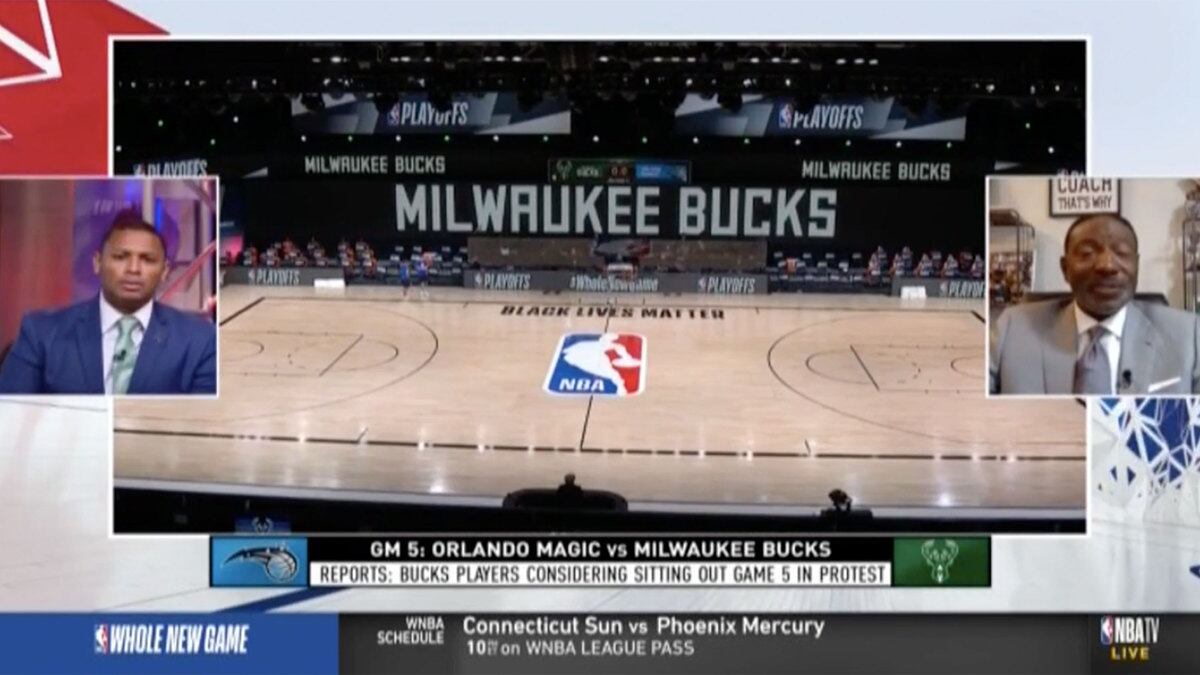This is a preview of our pop culture newsletter The Daily Beast’s Obsessed, written by senior entertainment reporter Kevin Fallon. To receive the full newsletter in your inbox each week, sign up for it here.
The most powerful thing to happen on TV this week was nothing.
I can’t remember the last time I watched an NBA game. I don’t watch sports. I’m the cliché who can’t even complain about the homophobia of calling the Tony Awards “the Super Bowl for gays” because for this gay, the Tony Awards is the Super Bowl.
ADVERTISEMENT
But after the news that, in response to the shooting of Jacob Blake by police in Wisconsin, the Milwaukee Bucks organized a strike and refused to play game five of the NBA’s first-round playoffs against the Orlando Magic, I revisited the 45 minutes or so of footage that played on NBA TV as the events unfolded. It was striking, historic television.
It starts with a wide shot of the court as “Fear the Deer” flashes on the Jumbotron. The Orlando Magic are warming up on one side of the arena, while the other half is conspicuously empty. The commentators start talking about the “developing situation” as it becomes clear that the Bucks are not only not coming out to warm up, but also are going to miss tip off.
The players from the Magic walk off to the locker room, and the court is empty. No spectators. No one on the floor. Just “Black Lives Matter” written on the court.
As they begin to receive confirmation that this is a strike in reaction to the epidemic of police brutality—and the players’ frustrations over being captive entertainers in a NBA bubble while a nationwide revolution beckons—commentators fill the airtime talking about the significance of the video that showed a police officer shooting Jacob Blake seven times in the back. Former players call in and talk about their own experiences being Black and having fraught interactions with police, and what it’s like to know someone who has been shot and killed by cops.
Eventually, announcers Bob Fitzgerald and Jim Jackson start discussing the history of the civil rights movement, Jim Crow laws, racial profiling, “the cycle,” and trauma, all from the courtside media booth at a NBA game. Watching it, you’re engrossed. You recognize that what you’re witnessing is surreal in every way.
You don’t have to be a sports fan to recognize a monumental moment as it happens; that is why sports transcend. What you saw on screen stood in stark contrast, too, to the images of activism and protest that have cemented themselves in recent months: crowds of people taking to the streets en masse to demand action. The negative space here and the silence—whatever you think about the privilege of millionaire athletes involved—was profound.
Fed up with corporate, empty gestures from the NBA, the players served up an empty court.
Then, of course, there was the nothing that was the Republican National Convention, which aired this week across multiple channels.
As Stephen Colbert said on his show Wednesday night about his decision not to watch, “Why should we pay attention to what they’re saying if none of what they’re saying tonight is about what’s happening in America right now? Why should we watch their reality show if it doesn’t reflect our reality?”
If you did view the first few days of the RNC, you’d think the pandemic is over, the Black Lives Matter movement never existed, and the greatest threat facing America right now is cancel culture.
I’ve written before about how preoccupied this president and administration are with television, the TV news cycle, and orchestrating moments and narratives to fit their own script—and how shockingly bad they’ve been at it.
Then it was back when the president delivered a speech threatening military retaliation against BLM protesters, unaware that CNN was airing in split-screen footage of police violently clearing demonstrators out of Lafayette Square to make way for his hollow photo-op at St. John’s Church. Now it’s the RNC pageant of ignorance, televised bombast that once again not only fails miserably to meet the moment, but is undermined by the footage of actual news happening alongside it.
Two major, influential organizations currently exist inside of bubbles. Only one appears to be able to see out into the real world.





